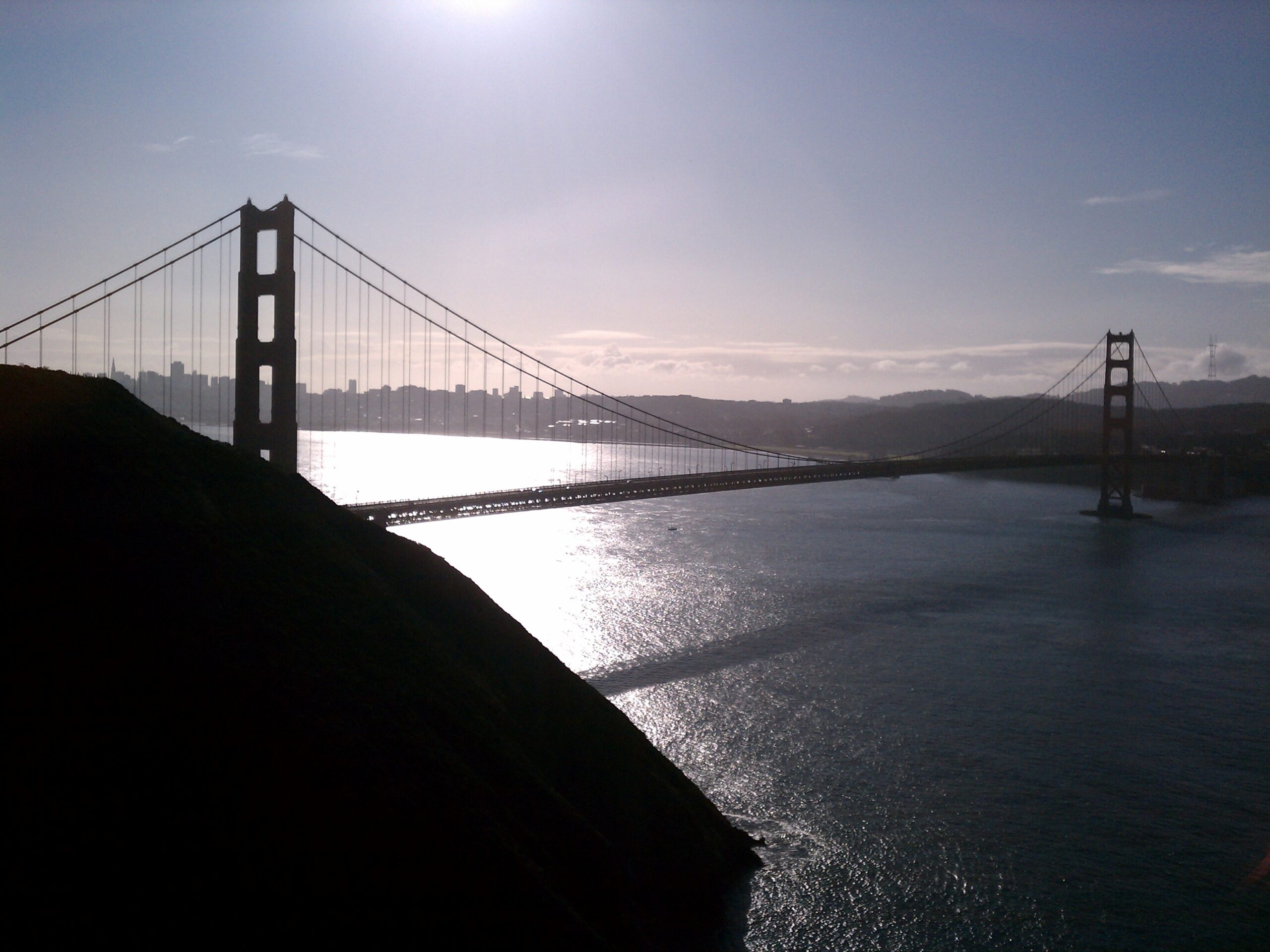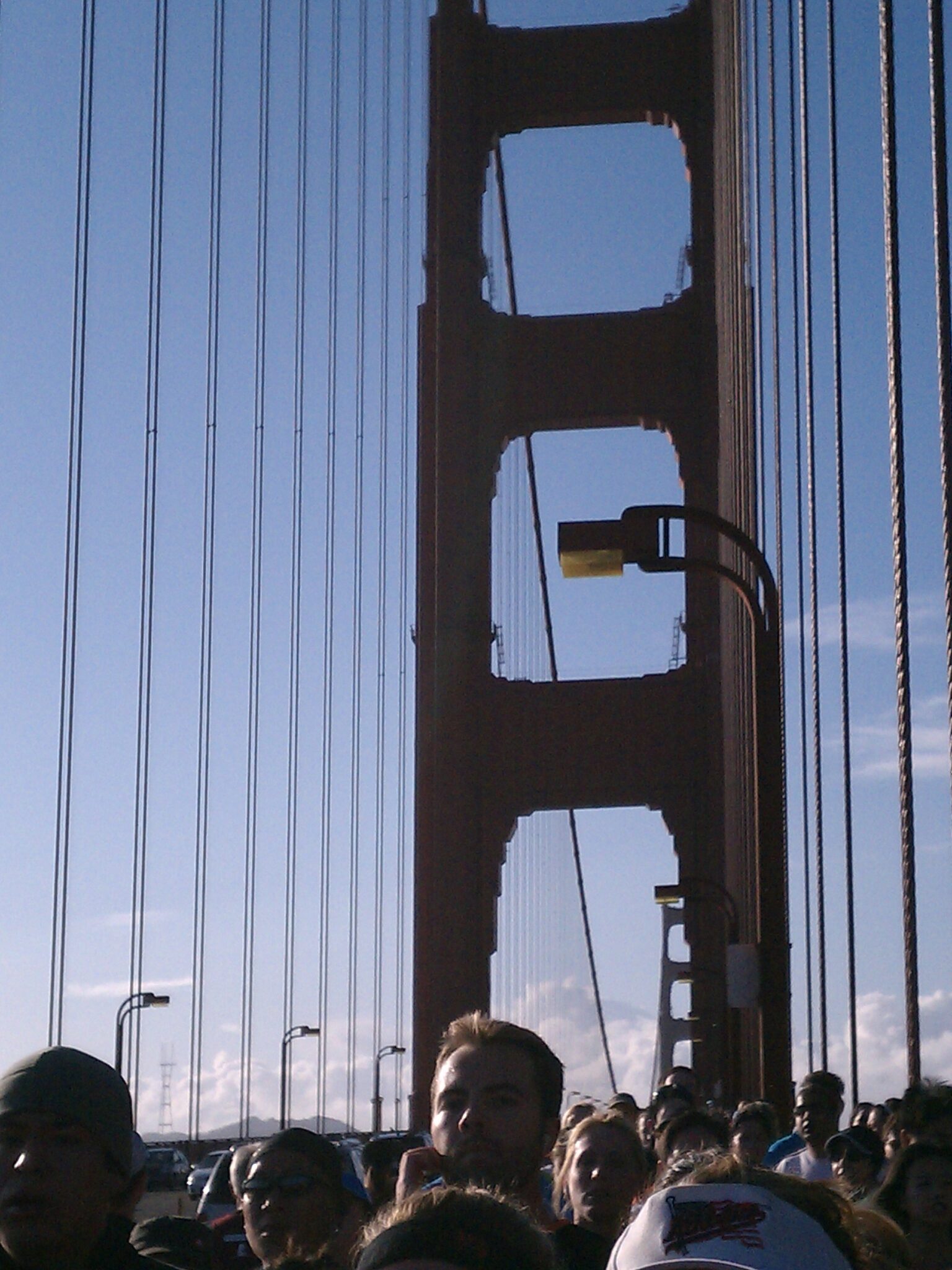
…because it would be hard
Weather report said it was going to rain. I talked to another runner before the race who said he hoped it wouldn’t rain. The skies were totally clear, but I don’t think rain on a race is a bad thing. It cools us off without having to sweat so much. Even without the rain, the air was pretty cool — probably about 55°F. A little cool to be standing around in shorts and a T‑shirt, but just fine for running. The skies were beautiful, it was a perfect day for the US Half Marathon.
Running 13.1 miles might not have been the safest or sanest thing to do for an out-of-shape 41-year old. Some might even say the last sentence shows my talent for understatement. I registered for the race almost a year ago and found nearly every excuse not to train for it. That had to end. Running the race today was both a line in the sand for my own running practice and an expiriment to test what the human body and spirit is capable of with little preparation. To paraphrase JFK, I ran not because it was easy, but because it would be hard, because that goal would serve to organize and measure the best of my energies and skills, because that challenge is one that I was willing to accept, one I was unwilling to postpone.
I ought to disclaim this with a warning not to try this yourself. If you’re out of shape, take strenuous activity very seriously and don’t just dive in to a challenge that could get you injured or worse. I’m out of shape today, but I am a moderately experienced runner so I knew most of what I was getting myself into. Though it really doesn’t count as training, I did test myself with shorter distances starting two weeks before the race. After I completed 9.6 miles last Saturday I had a reasonable idea of what I could expect in this half marathon.
I knew it wouldn’t be quick. Trying to run 13.1 miles fast would really be an invitation to injure myself and likely not finish at all. I had to pace myself and go very slowly. My only goal today was to finish before the course closed three hours after the start. I didn’t quite hit my mark, coming in two minutes over three hours, but they didn’t close the course or scoop me up in the sag wagon. In fact, the online results listing recorded two hundred finishers behind me. The US Half website’s FAQ says that participants unable to finish in three hours will be transported to the finish by race officials. Thankfully, that did not happen.
I arrived at the start line just in time for the starting gun. I followed the fence back to where I could join the crowd and started a slow trot. At the starting gate of a race with 3500 participants, maintaining an easy pace isn’t a problem — it’s the only option.
Around two and a half miles in, right on schedule, I started to get that feeling that I could do this all day. That was at the West end of Chrissy Field though, and I could see that the course was about to head into hills. That’s fine though. The hills in the Presidio are fairly gentle. The steepest incline we faced was downhill.
There is a lot of construction going on in the Presidio, so the race route has changed and the Presidio is not as scenic as usual. Eventually we found our way up to the South end of the Golden Gate Bridge. Behind me, a car tried to get in to the parking lot the usual way and the police officer who kept the course safe yelled something about, «what the hell do you think the orange cones are for?» Yeah, note to self: when driving, look for orange cones and don’t try driving into a crowd of runners. At least not when there’s a cop watching.
I tried to get photos of the Bridge while running but after a half dozen attempts gave up. Stupid Android.
More construction on the Bridge meant further modification to the usual race route. The Eastern sidewalk is closed, so the race went out across the Bridge and back on the same side. I’ve bicycled on the Western sidewalk, but I’ve never been a Northbound pedestrian before. What really impressed me was the Bridge’s shadow on the water below us. For some reason looking up at the bridge provides a different sense of scale. Watching the shadow on the water, the shadow looked enormous in a way that’s not visually apparent when looking lengthwise down the bridge.
Everyone kept to their side for the most part, but at the North end of the Bridge (6.25 miles in) there was a traffic bottleneck that kept us stopped for at least five minutes. It was enough time for me to actually get a picture taken of runners standing around, tweet my location and my status as a non-running runner. That took three or four tries so yes, it was a few minutes.

Once the bottleneck was past, the course went up into the Marin Headlands where the runners were treated to an awesome view of the Bridge and City, then back down, past the bottleneck area (which was much clearer due to the small number of runners slower than me) and South across the Bridge.
It was at about eight and a half miles in that I started to lose steam. That was about midway across the Bridge on the way back South. I told myself that it was all downhill from there and that I was two-thirds in, but I was feeling the bone-deep hunger that comes from running out of fuel. I told myself that it was only the feeling of my body starting to burn fat, but maintaining even the slow pace I had been keeping became more difficult. From then on, walk breaks became more frequent and it became tougher to get started running once I’d dropped to a walk.
At ten miles I announced that we’d all done the warmup and that it was time to start running today’s 5K race. It was a bit of bravado but I was going downhill and could actually let myself pick up a little speed.
At the bottom of that hill in addition to the water and Cytomax at the aid station a woman at the side of the road handed me a chocolate PowerGel. I hoped that I’d be able to access the energy and push through. Nonetheless, I walked through most of Chrissy Field. It was there that my hip started to hurt.
When I crossed to the Marina Green, I decided it was time to run again. I’ve run the Marina Green dozens of times. From there it was all road I know well and I thought it ought to be a breeze. I looked at the time. With about a mile and a half to go I had twenty minutes to make it to the finish line. It seemed doable, but my glutes were complaining and my left hip really didn’t want to keep going. And then there was the issue of the hill at Fort Mason. It’s not a very long hill, but I knew it would slow me down.
I pushed through the discomfort — there were no sharp pains to give me cause for alarm. My body was telling me to stop, but I wasn’t actually harming myself. I didn’t stop to walk until I reached the bottom of the hill. I knew I wouldn’t run uphill much faster than I’d walk it, and I wanted whatever I had left to be available for the final stretch to the finish line.
As the hill flattened out I started to take deliberate control of my breath and psyched myself for that last half mile. Leaning forward and getting off my heels was the last thing I was ready for, but I did it one last time. I came down the East side of the hill at Fort Mason and I could see Aquatic Park and all the way across to the finish line. I descended as freely as I could but my glutes and left hip were telling me to stop. As I reached the bottom of the hill I heard the finish line announcer state that there were 30 seconds left to get in under three hours. I tried to carry as much momentum as possible as I turned onto Van Ness and poured everything I had left into my final «sprint» which was only about a ten to eleven minute mile pace.
Aquatic Park doesn’t look that big unless it’s the last three-tenths of a mile in a half marathon. I’ve run that sidewalk countless times, but this was the third time I’d run it at the end of a 13.1‑miler. That space stretches out and it looks like a very long way to run. Then I gave up listening to my body’s complaints, shut them out, and put whatever I had left into moving my legs. That was when I broke emotionally. Something changed and it was no longer about having something to prove but instead about something to learn. I wasn’t running to prove that I could finish, I was running to find out whether I could finish. Tears were streaming down my face as I got closer to the gate. I heard other people’s names being announced as they crossed the line ahead of me. I passed three or four people in that last three tenths of a mile. I saw my friend who had come to see me finish as she cheered for me. I ran past her and into the chute, and then I heard the announcer say my name, and I was gratified that he pronounced it right. I crossed through the gate and it was done.
I found that though I was out of fuel, I couldn’t eat anything for nearly two hours. I nibbled what I could but couldn’t get down more than a bite every few minutes. This was the most difficult race finish I’ve ever had. It’s certainly not the biggest challenge I’ve faced; I’ve done two half-marathons before and the olympic distance triathlon I did in 2004 was more demanding. But those times I’ve had more to give. I was in decent condition and not carrying so much extra weight. I’ve never run a race with so great a possibility that I might not finish. I believed I could, but I was a long way from knowing that I could.
Today’s finish is also significant in that it strips me of excuses. I don’t have to carefully «train up» to six or seven mile runs. It’s not a license for recklessness, but it is a reminder that I am capable of finishing what I start. I could do it better, less painfully, faster, and look better doing it if I train and condition, but I don’t have prerequisites attached to pushing the limits of my endurance.
It’s said that lawyers should never ask questions in court unless they already know the answers. In life outside the courtroom and especially in regard to exploring our own capabilities, we ought always ask questions for which we don’t have an answer.
Good job
It’s great to hear that you did this, and I am proud of your accomplishment. I’ve been rediscovering pastimes that I once loved but set aside or neglected.
Now I really want to watch The Games with you.